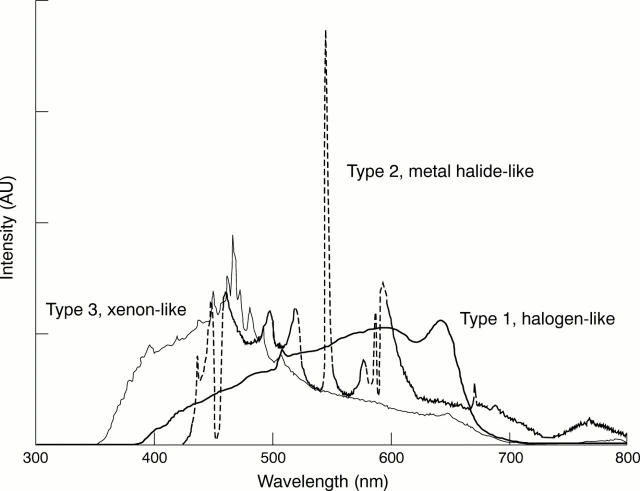Abstract
AIM—To assess the retinal phototoxicity hazards of and to provide safety margins for endoillumination during vitrectomy. METHODS—The absolute power and spectral distribution from various light sources and filter combinations that are commercially available for vitreous surgery were measured. The maximal exposure times based on the ICNIRP safety guidelines for photochemical and thermal injury of the aphakic eye were calculated. Additionally, the effect of various measures that reduce the risk of phototoxicity was evaluated. RESULTS—Measurements of the spectrum and energy indicated that the ICNIRP safety guidelines for photochemical retinal damage are exceeded within 1 minute for nine out of 10 combinations tested. With an additional 475 nm long pass filter, light levels below 10 mW, and a distance from light probe to retina of at least 10 mm, the allowable exposure time can be increased up to 13 minutes. Thermal damage can be anticipated when the light probe touches the retina. CONCLUSION—Commercially available light sources for endoillumination during vitrectomy are not safe with respect to photochemical retinal damage. Even with maximal precautions macular phototoxic damage remains a factual danger during vitrectomy.
Full Text
The Full Text of this article is available as a PDF (134.4 KB).
Figure 1 .
Spectral radiance of the three types of light sources investigated in this study. The spectral distributions are normalised to their integrated radiances.
Selected References
These references are in PubMed. This may not be the complete list of references from this article.
- Banker A. S., Freeman W. R., Kim J. W., Munguia D., Azen S. P. Vision-threatening complications of surgery for full-thickness macular holes. Vitrectomy for Macular Hole Study Group. Ophthalmology. 1997 Sep;104(9):1442–1453. doi: 10.1016/s0161-6420(97)30118-3. [DOI] [PubMed] [Google Scholar]
- Gorgels T. G., van Norren D. Ultraviolet and green light cause different types of damage in rat retina. Invest Ophthalmol Vis Sci. 1995 Apr;36(5):851–863. [PubMed] [Google Scholar]
- Ham W. T., Jr, Mueller H. A., Ruffolo J. J., Jr, Clarke A. M. Sensitivity of the retina to radiation damage as a function of wavelength. Photochem Photobiol. 1979 Apr;29(4):735–743. doi: 10.1111/j.1751-1097.1979.tb07759.x. [DOI] [PubMed] [Google Scholar]
- McDonald H. R., Verre W. P., Aaberg T. M. Surgical management of idiopathic epiretinal membranes. Ophthalmology. 1986 Jul;93(7):978–983. doi: 10.1016/s0161-6420(86)33635-2. [DOI] [PubMed] [Google Scholar]
- Michels M., Lewis H., Abrams G. W., Han D. P., Mieler W. F., Neitz J. Macular phototoxicity caused by fiberoptic endoillumination during pars plana vitrectomy. Am J Ophthalmol. 1992 Sep 15;114(3):287–296. doi: 10.1016/s0002-9394(14)71792-1. [DOI] [PubMed] [Google Scholar]
- Poliner L. S., Tornambe P. E. Retinal pigment epitheliopathy after macular hole surgery. Ophthalmology. 1992 Nov;99(11):1671–1677. doi: 10.1016/s0161-6420(92)31746-4. [DOI] [PubMed] [Google Scholar]
- Postel E. A., Pulido J. S., Byrnes G. A., Heier J., Waterhouse W., Han D. P., Mieler W. F., Guse C., Wipplinger W. Long-term follow-up of iatrogenic phototoxicity. Arch Ophthalmol. 1998 Jun;116(6):753–757. doi: 10.1001/archopht.116.6.753. [DOI] [PubMed] [Google Scholar]



